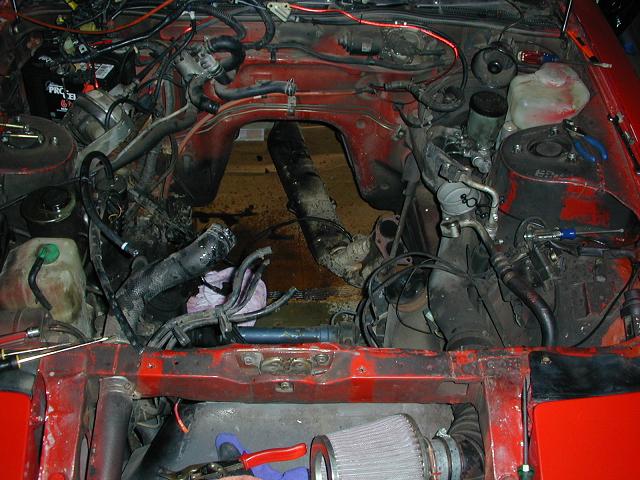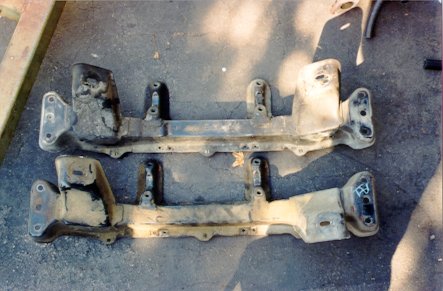
I ran into some troubles here. First off, you will have to remove the drivers side exhaust manifold, and chances are you will break studs in the process. Also, if you get lucky like I did, most of the heat shield bolts will break off as well. Here is your decision for how to do the crossmember, oil pan and exhaust manifold swap:
Option A: Try your best to get the manifold off in the cramped engine bay, if you break any bolts plan on getting an angle drill. Also you should plan on irritating bolts you cannot get to, and a sore back. Keep in mind you still have to swap the alternator (as well as extend the wiring harness) to the other side and swap the cross-member.
Option B: Remove the engine. Best done with the transmission attached.
For all too many reasons I decided on B and will have to recommend it to anyone attempting this conversion. It makes it far easier to change the manifold, crossmember and oil pan with the engine out of the car.
Take your time and go slowly, removing the engine is not very hard, but it can be if you build it up in your mind to be. You will need an engine hoist and recommended load leveler.

Removal of the crossmember is pretty simple. Unbolt the 4 nuts (two on either side) holding the crossmember to the frame rails, then remove the two bolts securing your front control arms to the crossmember. Next remove the A/C and PS line brackets that bolt to the front of the crossmember. The steering rack can be left in place once it is unbolted from the crossmember, but once you begin to lower the crossmember down it will need to be supported somehow. I just placed a length of 2x4 underneath it to hold it in place. The physical difference in the Z31 front crossmember is pictured blow. The top is NA and the bottom is Turbo, down is towards the front of the car:

The oil pan swap is needed only for the oil return fitting that came on turbo oil pans. You could install this type of return fitting on a NA oil pan, but purchasing a used turbo oil pan will usually work out to be cheaper anyway. You can obtain a replacement oil pan gasket (for 84-1/87 cars only, W-series VG30 uses RTV for a oil pan gasket) from the dealer for about $14, or from NAPA for about $8. Use small ratchet and extension to reach and loosen the small 10mm bolts that secure the pan to the engine block while the engine is still hooked on the hoist and off the ground. This will allow you to easily remove the pan from below with no obstruction. If your pan is the gasketed type, use RTV in the spots designated by the FSM to hold it in place during installation of the new oil pan.
BE AWARE of where your dipstick is when you put the pan on. Many people, myself included, have installed the pan with the dipstick in and not realized it until the new oil pan was completely installed. This causes the end of the dipstick to get caught, and the dipstick won't pull out. The only way to fix this is to remove the pan and make sure the dipstick is removed when you install the oil pan.
Locate and remove the small plug in the lower front on the drivers side of the engine block. This is where your turbo oil supply line is attached using two crush washers and a banjo bolt.
Now is also a very good time to swap to the turbo downpipe and remove the driveshaft. If you can't or didn't find a good used turbo downpipe, you can buy a very nice aftermarket replacement from Dave at Certified Muffler.

Turbo conversion pages: